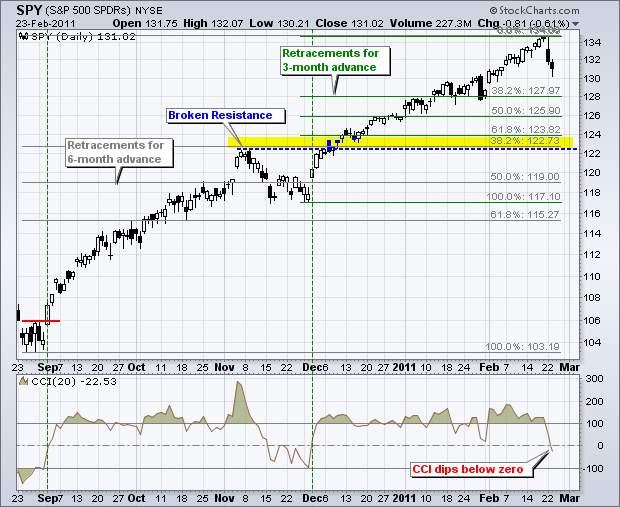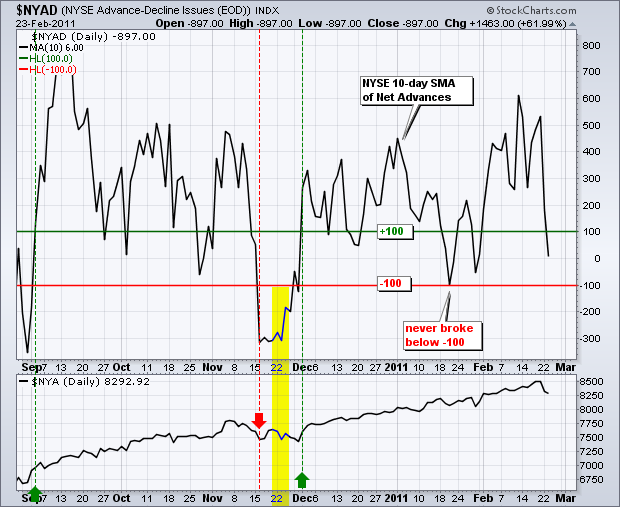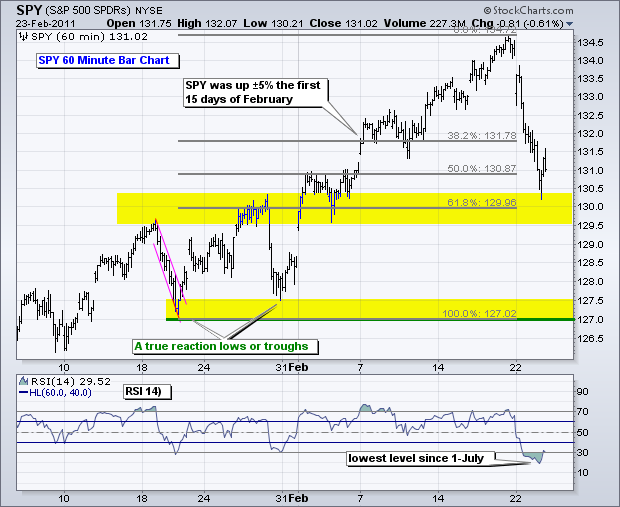On the 60-minute chart, the S&P 500 ETF (SPY) hit the main support zone around 130 on Wednesday afternoon and bounced. This bounce does not look that strong though as stocks sold off in the final 30 minutes of trading. A strong bounce would have finished strong. With the SPY trading near the mid point of its February range, it is difficult to predict short-term action. There could be a short-term oversold bounce back to the 132.7 area or further weakness towards support in the 127.5 area. Currently, I do not see any bearish or bullish patterns from which to trade at the moment. The only potentially bullish setup is for an oversold bounce off the 130 area. This is also predicated on the CBOE Volatility Index ($VIX) mean reversion strategy presented in Wednesday's market message (turn bullish when $VIX exceeds its 10-day EMA by more than 5%). Despite prior success with this strategy, I remain skeptical of a bounce because West Texas Intermediate is up around $4 this morning and trading above $100. I do not envision any sustained buying pressure as long as oil remains above $100. It is not so much the level, but rather the suddenness of the spike over the last two weeks. The daily chart lays out some Fibonacci clusters to target an extended correction or pullback over the next few weeks.

Short-term breadth indicators have turned mixed. The 10-day SMAs for Nasdaq Net Advances ($NAAD) and Nasdaq Net Advancing Volume ($NAUD) moved below -100. Both turned bullish with moves above +100 the first week of February. The 10-day SMAs for NYSE Net Advances ($NYAD) and Net Advancing Volume ($NYUD) turned bullish the first week of December and remained in bull mode the last three months because they never broke -100. Confirming signals from the NYSE indicators would turn breadth fully bearish. The short-term evidence for breadth is split right now. Elsewhere, momentum is bearish as RSI broke below 40 and became oversold. This was also the situation in late January when breadth was split, momentum was bearish and SPY was still above its last TRUE reaction low. Call me a nitpicker, but I cannot label the short-term SPY trend as down because the ETF has yet break a support level as defined by a TRUE reaction low.


Key Economic Reports/Events:
Feb 24 - 08:30 - Jobless Claims
Feb 24 - 08:30 - Durable Orders
Feb 24 - 10:00 - New Home Sales
Feb 24 - 11:00 - Oil Inventories
Feb 25 - 08:30 - GDP
Feb 25 - 09:55 - Michigan Sentiment
Charts of Interest: Tuesday and Thursday in separate post.
-----------------------------------------------------------------------------
This commentary and charts-of-interest are designed to stimulate thinking. This analysis is not a recommendation to buy, sell, hold or sell short any security (stock ETF or otherwise). We all need to think for ourselves when it comes to trading our own accounts. First, it is the only way to really learn. Second, we are the only ones responsible for our decisions. Think of these charts as food for further analysis. Before making a trade, it is important to have a plan. Plan the trade and trade the plan. Among other things, this includes setting a trigger level, a target area and a stop-loss level. It is also important to plan for three possible price movements: advance, decline or sideways. Have a plan for all three scenarios BEFORE making the trade. Consider possible holding times. And finally, look at overall market conditions and sector/industry performance.

